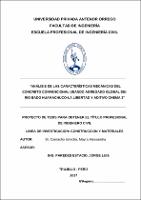Mostrar el registro sencillo del ítem
Análisis de las características mecánicas del concreto convencional usando agregado global del río Bado Huamachuco - La Libertad y aditivo Chema 3
| dc.contributor.advisor | Paredes Estacio, Jorge Luis | |
| dc.contributor.author | Camacho Urtecho, Mayra Alessandra | |
| dc.creator | Camacho Urtecho, Mayra Alessandra | |
| dc.date.accessioned | 2018-02-08T14:53:22Z | |
| dc.date.available | 2018-02-08T14:53:22Z | |
| dc.date.issued | 2017 | |
| dc.identifier.uri | https://hdl.handle.net/20.500.12759/3603 | |
| dc.description.abstract | El agregado global se utiliza en la industria de la construcción (sierra). Se caracteriza por ser natural en la corteza terrestre y se emplea tal cual se extrae de la cantera del Rio Bado, cuyo tamaño máximo es 1’’, el agregado grueso es de forma redondeada y semiredondeada, el agregado fino es arena de rio; este material es empleado de dos formas; separando el grueso y el fino por el tamiz n°4’’ para preparar un concreto patrón; también empleando el hormigón de forma global. El agua empleada en la investigación es agua potable de las instalaciones del laboratorio de ensayo de la UPAO. La propiedad del agregado global con el concreto que facilita su ingreso es su permeabilidad. En este estudio se realizaron ensayos para medir su resistencia, aplicando aditivo Chema3. la presente tesis se resume en determinar las características y propiedades de los materiales empleado por el método de ‘’fuller’’, se utiliza cemento Portland tipo Ico ‘’Pacasmayo’’ cuyo peso específico es de 3150 kg/m³, en resistencia a compresión a los 28 días, todo esto para el concreto denominado diseño (Concreto patrón). Se establece el diseño para el agregado global del Rio Bado para las relaciones a/c (0.40, 0.45, 0.50, 0.55), se repitió cada mezcla tres veces con el objetivo de tener mayores resultados. Con este ensayo, se elaboró una gráfica para establecer el diseño final Fꞌc=210kg/cm², para las relaciones 7, 14 y 28 días con aditivo y sin aditivo Chema3 en estado fresco obteniendo un slump de 3’’, c on los resultados de este ensayo, se elaboraron curvas y gráficos vs relación a/c y vs relación días. Estos resultados sirvieron para concluir que el diseño inicial (concreto patrón) varia respecto a la relación a/c, que a menor relación a/c mayor resistencia y el diseño final Fꞌc=210kg/cm² aumenta la resistencia a la compresión, respecto a la relación en días, que a mayor días mayor resistencia. Esta tesis ha sido determinada para demostrar que el aditivo genera mayor resistencia en menor tiempo y que es necesario para las construcciones a menor plazo. | es_PE |
| dc.description.abstract | The global aggregate is used in the industry of construction (sierra). It is characterized by being natural in the Earth's crust and used such which is extracted from the quarry of the Rio Bado, whose maximum size is 1““, the added thickness is rounded, the fine aggregate is River sand; This material is used in two ways; separating the thick and the thin by sieve n°4““ to prepare a specific pattern; also using concrete on a global basis. The water used in the research i s drinking water from the the UPAO testing laboratory facilities. The property of the global aggregate with concrete which facilitates its entrance is its permeability. In this study, tests were performed to measure its resistance, by applying additive Chema3. the present thesis is summarized in determining the characteristics and properties of the materials used by the '' fuller '' method, this is used Portland cement type Ico ““Pacasmayo““ whose specific weight is of 3150 kg/m³, the 28-day compressive strength, all the concrete called design (concrete pattern). Sets the design for aggregate global Rio Bado for relations them (0.40, 0.45, 0.50, 0.55), a/c recurred each mixture three times in order to have better results. With this test, a graph was prepared to establish the final design Fꞌc = 210 kg/cm², for relations 7, 14 and 28 days with additive and non-additive Chema3 in fresh state obtaining a slump of 3’’, With the results of this trial, curves and graphics vs relationship were developed w/c and vs relationship days. These results served to conclude that the initial design (concrete pattern) varies with respect to the w/b ratio, which in lower w/c relation greater resistance and the final design Fꞌc = 210 kg/cm increases the resistance to compression, with respect to the relationship in days, that a more days more resistance. This thesis has been determined to show that the additive generates more resistance in shortest time and that it is necessary for the shortest buildings. | en_US |
| dc.description.uri | Tesis | es_PE |
| dc.format | application/pdf | es_PE |
| dc.language.iso | spa | es_PE |
| dc.publisher | Universidad Privada Antenor Orrego - UPAO | es_PE |
| dc.relation.ispartofseries | T_ING.CIVIL_1494 | |
| dc.rights | info:eu-repo/semantics/openAccess | es_PE |
| dc.source | Universidad Privada Antenor Orrego | es_PE |
| dc.source | Repositorio Institucional - UPAO | es_PE |
| dc.subject | Concreto convencional | es_PE |
| dc.subject | Agregado global | es_PE |
| dc.title | Análisis de las características mecánicas del concreto convencional usando agregado global del río Bado Huamachuco - La Libertad y aditivo Chema 3 | es_PE |
| dc.type | info:eu-repo/semantics/bachelorThesis | es_PE |
| thesis.degree.level | Título Profesional | es_PE |
| thesis.degree.grantor | Universidad Privada Antenor Orrego. Facultad de Ingeniería | es_PE |
| thesis.degree.name | Ingeniero Civil | es_PE |
| thesis.degree.discipline | Ingeniería Civil | es_PE |
Ficheros en el ítem
Este ítem aparece en la(s) siguiente(s) colección(es)
-
Ingeniería Civil [1085]

